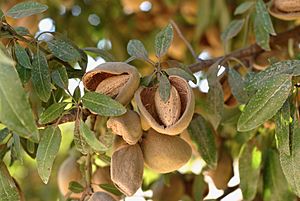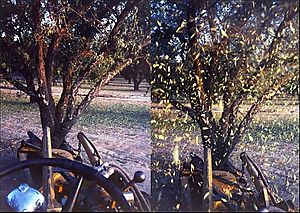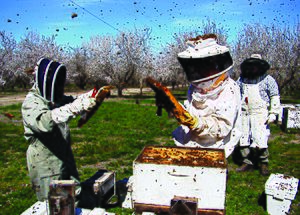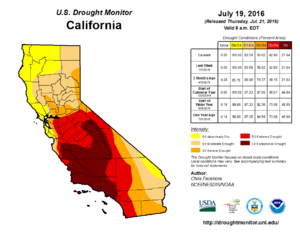Almonds in California facts for kids
Did you know that California grows most of the world's almonds? In fact, it produces 100% of the almonds sold in the United States! Even though almonds didn't originally come from California, the state's warm, dry weather, like a Mediterranean climate, and its water systems are perfect for growing them.

In 2020, about 1.25 million acres of land in California were used for almond farms. These farms produced an amazing 2.8 billion pounds of almonds! Almonds are California's most valuable crop that is sent to other countries. In 2019, farmers sold $4.9 billion worth of almonds to places like the European Union, China, and India. This was about 22% of all the farm products California sent overseas.
Growing so many almonds needs a lot of help from bees. Most of the commercial bee colonies in the U.S. are brought to California during the almond blooming season to help pollinate the trees. However, growing almonds in California also causes some big environmental issues. These include using a lot of water and creating a lot of almond shell waste. Because of a long-term drought in California, almond production was expected to go down in 2021. Many almond farms were even being left empty.
Also, during the COVID-19 pandemic in 2020-21, it became harder to ship almonds. People also spent less money, and trade disagreements made it tough to sell almonds.
Contents
Almonds and California's Economy
Almonds are a huge part of California's economy. In 2019, they were the third most valuable farm product, bringing in $4.9 billion. This was about 11% of all the money made from farming in the state. Almond production has grown a lot, from 703 million pounds in 2000 to 2.27 billion pounds in 2017. The prices for almonds also went up during this time, partly because more countries wanted to buy them.
The almond industry has grown thanks to new machines. When it's time to harvest, special machines called tree shakers are used. These machines shake each almond tree very hard, making the nuts fall to the ground. This means fewer people are needed to pick the almonds compared to other crops. This has been helpful for farmers who worry about not having enough workers.
A report from 2014, ordered by the Almond Board of California, showed how important the industry is. It directly employed 21,000 people. It also supported another 83,000 jobs across the state. Overall, the almond industry added about $11 billion to California's economy.
Selling Almonds to Other Countries
Almonds are California's most valuable farm product that is exported. In 2016, farmers sold $4.5 billion worth of almonds to other countries. This was about 22% of all the farm products California sent overseas. Most of these almonds went to the European Union, China, and India. While the EU buys the most, China and India are growing markets. The California Almond Board has worked hard to promote almonds as a healthy snack in these countries.
During the 2018 China–United States trade war, China added an extra 50% tax on almonds. Because of this, some Chinese businesses started buying almonds from other places like Africa and Australia.
In 2021, there were problems with shipping at U.S. ports. Shipping companies often chose to send empty containers back to Asia quickly to pick up more goods, rather than waiting to fill them with U.S. exports like almonds. This meant that more than three-quarters of the containers leaving Los Angeles in July 2021 were empty. This caused delays for almond growers and other farmers who ship their products overseas.
Environmental Concerns
Bees and Pollination
Like many plants, almond trees need help from insects to make nuts. This process is called cross-pollination. Even though many insects can pollinate almonds, commercial almond farms rely heavily on honey bees. Almond growers often rent beehives during the spring blooming season to make sure their trees are pollinated well.
Around 2006, California almond growers started to see problems with bee populations. This was due to something called colony collapse disorder. This is when many bees in a hive suddenly disappear. This problem made it more expensive for growers to rent bees. However, because there was such a high demand for almonds, farmers still paid to bring bees from all over the United States to California. The bee population in California has since gotten better. In 2018, more than half of all bee colonies in the U.S. were in California.
Water Use
California had a very bad drought from 2011 to 2017. This caused problems for almond growers. The almond industry also faced criticism for how much water it used. In 2015, growing almonds used about 10% of all the water in California. From 2007 to 2014, the amount of land used for almonds grew by 14%. But the amount of water used for almond irrigation went up by 27%. Some people pointed out that California's 6,000 almond farmers used about 35 times more water than the 466,000 people living in Sacramento.
To get enough water, many almond farmers pumped more water from underground. This can dry up underground water sources called aquifers. It can also cause the land to sink, which is called subsidence.
Almond production dropped a bit because of the drought. This led to higher prices and less demand from buyers. To deal with this, many farmers removed older almond trees that didn't produce as much. They replaced them with newer trees that use less water. Since these new trees take about five years to start producing nuts, some farmers are worried about having too many almonds in the future.
Almond Waste Products

When almonds are harvested, they produce a lot of waste. In the 2015/2016 growing season, the California almond industry produced over 1.5 million metric tons of hulls (the soft outer layer) and over 0.5 million metric tons of shells (the hard outer layer). In the past, these byproducts were used as food or bedding for farm animals, or as fuel for power plants. However, there's less demand for these uses now, but more almonds are being produced. This creates a problem with too much waste.
The Almond Board of California is looking for new ways to use these almond byproducts in other industries, like food, cars, and medicines. One idea is to use them as feedstock for bioenergy. For example, biochar made from almond shells can be added to car and airplane tires. This helps the tires handle different temperatures better. Biochar can also be used to make stronger, biodegradable plastic items, like garbage bags and flower pots.
Another good idea for sustainability is "whole orchard recycling." When almond trees are too old to produce many nuts, the entire tree is ground up. These ground-up remains are then mixed back into the soil. This helps the soil keep the tree's nutrients. It also helps the soil hold more water.
Almond Pests
Almond trees, like many crops, can be affected by pests. One important pest is Ferrisia gilli. This insect causes a lot of damage to almonds and pistachios in California. It was once thought to be another type of mealybug, but scientists realized it was different because of its big impact on these crops.
Another problem for almonds is a disease called Xanthomonas pruni. This disease was not known in California until it was found in Sacramento and the northern San Joaquin Valley in 2013.
The Amyelois transitella, also known as the navel orangeworm, is one of the worst pests for almonds. The larvae of this worm cannot chew through the fresh hull of an almond. So, the adult worms lay their eggs on old, fallen almonds from the previous year. Then, in mid-June or early July, when the new almond hulls start to split open, the worms attack the fresh crop. The amount of damage from navel orangeworms changes each year. This is because how well the worms survive the winter depends a lot on the old almonds left on the ground and the type of almond tree.





